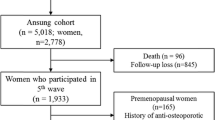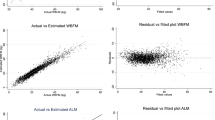Abstract
We have previously found that fat mass but not lean body mass is related to bone mineral density (BMD) in women. In these and most other studies of the dependence of BMD on body composition, areal rather than volumetric bone density was measured. It is possible that the dependence of this variable on body size introduced a scale artifact that contributed to the previous findings. The present study addresses this issue by measuring thevolumetric density of the third lumbar vertebra from simultaneous anteroposterior (AP) and lateral scans using dual-energy X-ray absorptiometry in 119 normal postmenopausal women. Whole body fat and lean body mass were also measured using this technique. In the AP projection, BMD was similarly related to body weight and to fat mass (r=0.44,p<0.0001 for both) but not to lean body mass (r=0.17, NS). BMD in the lateral projection was less closely related to body composition than was AP BMD, but the greater impact of fat (r=0.25,p<0.01) than lean body mass (r=0.09, NS) was still evident. When AP or lateral BMDs were divided by height, arm span or the square root of the scan area to produce an index with the dimensions of volumetric density, the dependence of BMD on body weight and fat mass were not affected but the relationship to lean body mass was eliminated (−0.02<r<0.09). Similarly, the volumetric density of the third lumbar vertebra was related to fat mass (r=0.21,p=0.02) but not to lean body mass (r=0.01). It is concluded that BMD is related to fat mass and that previously reported associations between lean body mass and BMD are probably contributed to by a scaling factor arising from failure to measure volumetric bone density.
Similar content being viewed by others
References
Farmer ME, Harris T, Madans JH, Wallace RB, Cornoni-Huntley J, White LR. Anthropometric indicators and hip fracture: the NHANES I epidemiologic follow-up study. J Am Geriatr Soc 1989;37:9–16.
Alffram P. An epidemiological study of cervical and trochanteric fractures of the femur in an urban population. Acta Orthop Scand (Suppl) 1964;65:1–109.
Wooton R, Breyson E, Elsasser U, et al. Risk factors for fractured neck of femur in the elderly. Age Ageing 1982;11:160–8.
Hutchinson TA, Polansky SM, Feinstein AR. Post-menopausal oestrogens protect against fractures of hip and distal radius: a case-control study. Lancet 1979;2:705–9.
Paganini-Hill A, Ross RK, Gerkins JR, et al. Menopausal estrogen therapy and hip fractures. Ann Intern Med 1981;95:28–31.
Williams AR, Weiss NS, Ure CL, et al. Effect of weight, smoking and estrogen use on the risk of hip and forearm fractures in postmenopausal women. Obstet Gynecol 1982;60:695–9.
Kreiger N, Kelsey JL, Holford TR, et al. An epidemiologic study of hip fracture in post-menopausal women. Am J Epidemiol 1982;116:141–8.
Baston MD, Rawlings J, Allison SP. Undernutrition, hypothermia, and injury in elderly women with fractured femur: an injury response to altered metabolism? Lancet 1983;1:143–5.
Kiel DP, Felson DT, Anderson JJ, et al. Hip fracture and the use of estrogens in postmenopausal women: the Framingham Study. N Engl J Med 1987;317:1169–74.
Alderman BW, Weiss NS, Daling JR, Ure CL, Ballard JH. Reproductive history and postmenopausal risk of hip and forearm fracture. Am J Epidemiol 1986;124:262–7.
La Vecchia C, Negri E, Levi F, Baroni JA. Cigarette smoking, body mass and other risk factors for fractures of the hip in women. Int J Epidemiol 1991;29:671–7.
Pruzensky ME, Turano M, Luckey M, Senie R. Low body weight as a risk factor for hip fracture in both black and white women. J Orthoped Res 1989;7:192–7.
Nguyen TV, Sambrook PN, Kelly PJ, Lord S, Freund J, Eisman JA. Body sway and bone mineral density are predictors of fracture prevalence: the Dubbo osteoporosis epidemiology study. J Bone Miner Res 1992;7 (Suppl 1):S112.
Newberry D, Wickham C, Hodkinson HM. How does obesity protect against osteoporosis? J Clin Exp Gerontol 1990;12:203–7.
Hassager C, Christiansen C. Influence of soft tissue body composition on bone mass and metabolism. Bone 1989;10:415–9.
Kleerekoper M, Peterson E, Nelson D, Tilley B, Phillips E, Schork MA, Kuder J. Identification of women at risk for developing postmenopausal osteoporosis with vertebral fractures: role of history and single photon absorptiometry. Bone Miner 1989;7:171–86.
Aloia JF, Cohn SH, Vaswani A, Yeh JK, Yen K, Ellis K. Risk factors for postmenopausal osteoporosis. Am J Med 1985;78:95–100.
Nordin BEC, Need AG, Bridges A, Horowitz M. Relative contributions of years since menopause, age, and weight to vertebral density in postmenopausal women. J Endocrinol Metab 1992;74:20–3.
Meema S, Reid DBW, Meema HE. Age trends of bone mineral mass, muscle width, and subcutaneous fat in normals and osteoporotics. Calcif Tissue Res 1973;12:101–12.
Dawson-Hughes B, Shipp C, Sadowski L, Dallal G. Bone density of the radius, spine, and hip in relation to percent of ideal body weight in postmenopausal women. Calcif Tissue Int 1987;40:310–4.
Mazess RB, Barden HS. Bone density in premenopausal women: effects of age, dietary intake, physical activity, smoking, and birth-control pills. Am J Clin Nutr 1991;53:132–42.
Cundy T, Evans M, Roberts H, Wattie D, Ames R, Reid I. Reduced bone density in women using depot medroxyprogesterone acetate for contraception. BMJ 1991;303:13–6.
Mazess R, Barden H, Ettinger M, et al. Spine and femur density using dual-photon absorptiometry in US white women. Bone Miner 1987;2:211–9.
Halioua L, Anderson JJB. Age and anthropometric determinants of radial bone mass in premenopausal caucasian women: a cross-sectional study. Osteoporosis Int 1990;1:50–5.
Slemenda CW, Hui SL, Williams CJ, Christian JC, Meaney FJ, Johnson CC. Bone mass and anthropometric measurements in adult females. Bone Miner 1990;11:101–9.
Haffner SM, Bauer RL. Excess androgenicity only partially explains the relationship between obesity and bone density in premenopausal women. Int J Obesity 1992;16:869–74.
van Beresteijn EC, van Laarhoven JP, Smals AG. Body weight and/or endogenous estradiol as determinants of cortical bone mass and bone loss in healthy early postmenopausal women. Acta Endoctrinol 1992;127:226–30.
Nelson DA, Kleerekoper M, Parfitt AM. Bone mass, skin color and body size among black and white women. Bone Miner 1988;4:257–64.
Kin K, Kushida K, Yamazaki K, Okamoto S, Inoue T. Bone mineral density of the spine in normal Japanese subjects using dual-emergy x-ray absorptiometry: effect of obesity and menopausal status. Calcif Tissue Int 1991;49:101–6.
Vesterby A, Mosekilde L, Gundersen HJG, Melsen F, Mosekilde L, Holme K, Sorensen S. Biologically meaningful determinants of the in vitro strength of lumbar vertebrae. Bone 1991;12:219–24.
Harris S, Dallal GE, Dawson-Hughes B. Influence of body weight on rates of change in bone density of the spine, hip, and radius in postmenopausal women. Calcif Tissue Int 1992;50:19–23.
Reid IR, Ames R, Evans MC, et al. Determinants of total body and regional bone mineral density in normal postmenopausal women: a key role for fat mass. J Clin Endocrinol Metab 1992;75:45–51.
Reid IR, Plank LD, Evans M. Fat mass is an important determinant of whole body bone density in premenopausal women but not in men. J Clin Endocrinol Metab 1992;75:1–4.
Carter DR, Bouxsein ML, Marcus R. New approaches for interpreting projected bone densitometry data. J Bone Miner Res 1992;7:137–45.
Mazess RB, Barden HS, Bisek JP, Hanson J. Dual-energy x-ray absorptiometry for total-body and regional bone-mineral and soft-tissue composition. Am J Clin Nutr 1990;51:1106–12.
Orwoll ES, Oviatt SK, Mann T. The impact of osteophytic and vascular calcifications on vertebral mineral density measurements in men. J Clin Endocrinol Metab 1990;70:1202–7.
Jones CD, Laval-Jeantet AM, Laval-Jeantet MH, Genant HK. Importance of measurement of spongious vertebral bone mineral density in the assessment of osteoporosis. Bone 1987;8:201–6.
Lindsay R, Cosman F, Herrington BS, Himmelstein S. Bone mass and body composition in normal women. J Bone Miner Res 1992;7 (Suppl 1):55.
Itabashi A, Saneshige S, Takeuchi A, Kashiwabara H, Ishii J. Body fat distribution and osteopenia in female diabetic patients measured by dual energy x-ray absorptiometry. Bone Miner 1992;17 (Suppl 1):168.
Compston JE, Bhambhani M, Laskey MA, Murphy S, Khaw KT. Body composition and bone mass in post-menopausal women. Clin Endocrinol 1992;37:426–31.
Bevier WC, Wiswell RA, Pyka G, Kozak KC, Newhall KM, Marcus R. Relationship of body composition, muscle strength, and aerobic capacity to bone mineral density in older men and women. J Bone Miner Res 1989;4:421–32.
Reid IR, Evans MC, Ames R. Relationships between upper arm anthropometry and soft tissue composition in postmenopausal women. Am J Clin Nutr 1992;56:463–6.
Sowers MR, Wallace RB, Lemke JH. Correlates of mid-radius bone density among postmenopausal women: a community study. Am J Clin Nutr 1985;41:1045–53.
Hickman J, McElduff A. Insulin promotes growth of the cultured rat osteosarcoma cell line UMR-106-01: an osteoblast-like cell. Endocrinology 1989;124:701–6.
Craig RG, Rowe DW, Petersen DN, Kream BE. Insulin increases the steady state level of alpha-1(I) procollagen mRNA in the osteoblast-rich segment of fetal rat calvaria. Endocrinology 1989;125:1439–7.
Canalis EM, Dietrich JW, Maina DM, Raisz LG. Hormonal control of bone collagen synthesis in vitor: effects of insulin and glucagon. Endocrinology 1977;100:668–74.
Reid IR, Evans MC, Cooper GJS, Ames RW, Stapleton J. Circulating insulin levels are related to bone density in normal postmenopausal women. Am J Physiol 1993;265:E655–9.
Rosner W. The functions of corticosteroid-binding globulin and sex hormone-binding globulin: recent advances. Endocr Rev 1990;11:80–91.
van Hemert AM, Birkenhager JC, De Jong FH, Vandenbroucke JP, Valkenburg HA. Sex hormone binding globulin in postmenopausal women: a predictor of osteoporosis superior to endogenous oestrogens. Clin Endocrinol (Oxf) 1989;31:499–509.
Plymate SR, Matej LA, Jones RE, Friedl KE. Inhibition of sex hormone-binding globulin production in the human hepatoma (hep g2) cell line by insulin and prolactin. J Clin Endocrinol Metab 1988;67:460.
Author information
Authors and Affiliations
Rights and permissions
About this article
Cite this article
Reid, I.R., Evans, M.C. & Ames, R.W. Volumetric bone density of the lumbar spine is related to fat mass but not lean mass in normal postmenopausal women. Osteoporosis Int 4, 362–367 (1994). https://doi.org/10.1007/BF01622199
Received:
Accepted:
Issue Date:
DOI: https://doi.org/10.1007/BF01622199




